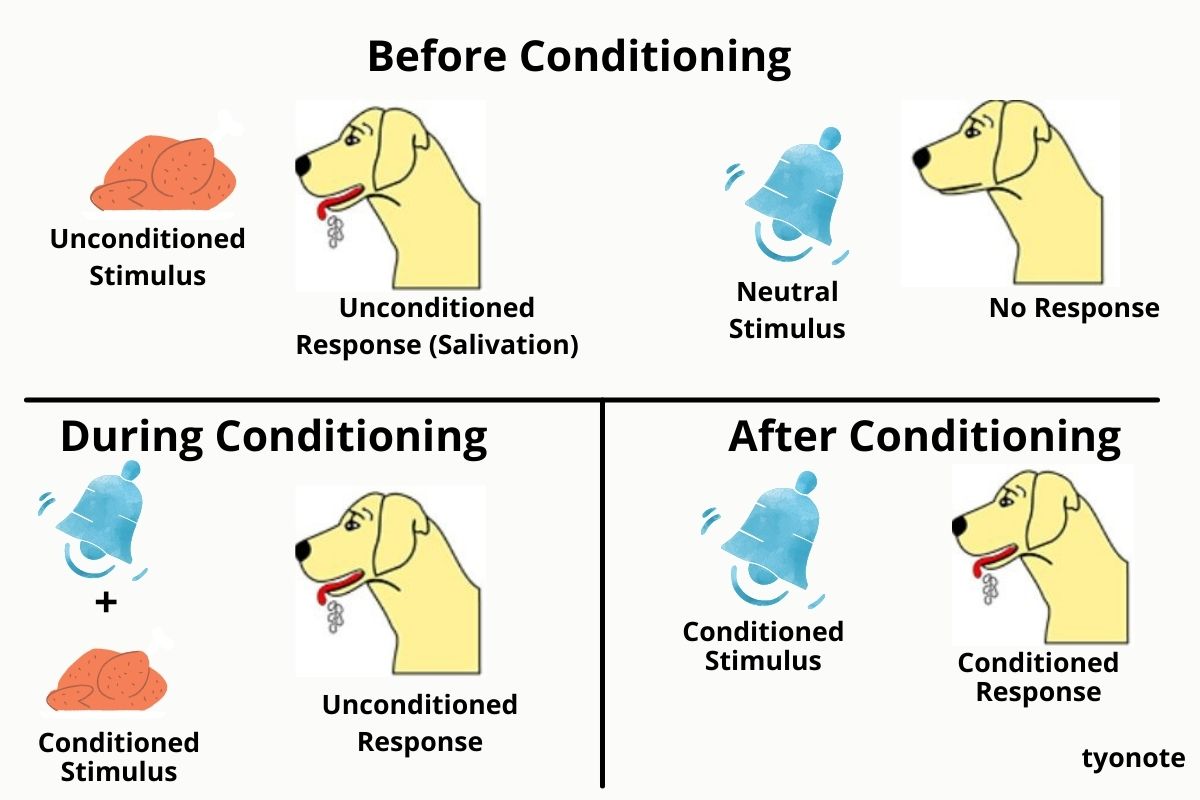Classical and Operant Conditioning
Classical and operant conditioning are two fundamental concepts in behavioral psychology that explain how learning occurs. Both were developed by influential psychologists and have distinct mechanisms, applications, and examples.
A. Classical Conditioning
Classical conditioning involves learning through association. A neutral stimulus becomes associated with an unconditioned stimulus to elicit a conditioned response. (Stimulus first before the response)Author: Ivan Pavlov, a Russian physiologist, is credited with discovering classical conditioning through his experiments with dogs.
Key Components:
- Unconditioned Stimulus (UCS): A stimulus that naturally triggers a response (e.g., food causing salivation).
- Unconditioned Response (UCR): A natural reaction to the UCS (e.g., salivation in response to food).
- Conditioned Stimulus (CS): A previously neutral stimulus that, after association with the UCS, triggers a response (e.g., a bell).
- Conditioned Response (CR): A learned response to the CS (e.g., salivation in response to the bell).
Example:
Pavlov's Dogs: Pavlov rang a bell (neutral stimulus) before presenting food (UCS). Over time, the dogs began to salivate (CR) at the sound of the bell (CS), even without food.
Applications:
- Phobias: Fear of spiders can develop if a person associates spiders (neutral stimulus) with a traumatic event (UCS).
- Advertising: Pairing a product (neutral stimulus) with positive imagery (UCS) to evoke a favorable response (CR).

B. Operant Conditioning
Operant conditioning involves learning through consequences, such as reinforcement or punishment, to increase or decrease a behavior. (Response first before stimulus)Author: B.F. Skinner, an American psychologist, expanded on the work of Edward Thorndike and introduced operant conditioning.
Key Components:
- Reinforcement: Increases the likelihood of a behavior.
- Positive Reinforcement: Adding a pleasant stimulus (e.g., giving a child candy for cleaning their room).
- Negative Reinforcement: Removing an unpleasant stimulus (e.g., turning off a loud alarm when waking up).
- Punishment: Decreases the likelihood of a behavior.
- Positive Punishment: Adding an unpleasant stimulus (e.g., a speeding ticket for driving too fast).
- Negative Punishment: Removing a pleasant stimulus (e.g., taking away a toy for bad behavior).
Example:
Skinner's Box: Skinner placed rats in a box where pressing a lever would dispense food (positive reinforcement). The rats learned to press the lever to receive food.
Applications:
- Education: Rewarding students for good grades (positive reinforcement).
- Parenting: Using time-outs for misbehavior (negative punishment).
:max_bytes(150000):strip_icc()/2794863-operant-conditioning-a21-5b242abe8e1b6e0036fafff6.png)
Note: Remember that when using a POSITIVE (+) reinforcement/punishment, we always add something (give additional, plus points, increase something, etc.). Otherwise, NEGATIVE (-) reinforcement/punishment always removes something (taking away, remove something, deduct, exclude, etc.).
Distinctions Between Classical and Operant Conditioning
| Feature | Classical Conditioning | Operant Conditioning |
|---|---|---|
| Focus | Involuntary, automatic behaviors | Voluntary behaviors |
| Key Mechanism | Association between stimuli | Consequences of behavior |
| Pioneers | Ivan Pavlov | B.F. Skinner |
| Examples | Salivating at the sound of a bell | Pressing a lever for food |
| Applications | Phobias, advertising | Education, parenting |
Classical and operant conditioning are powerful tools for understanding and influencing behavior. While classical conditioning focuses on involuntary responses through association, operant conditioning emphasizes voluntary behaviors shaped by consequences. Together, they provide a comprehensive framework for studying learning and behavior.
👍🏻 1.1k
Comments
Post a Comment
Tell us your feedback!